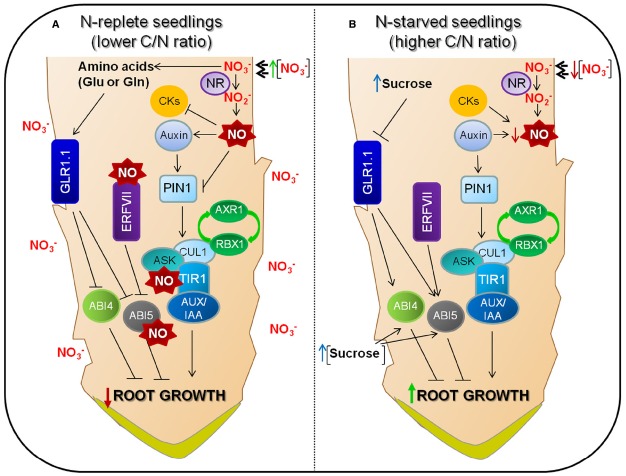FIGURE 2.
Molecular components of nitrate signaling networks and their involvement in root development. There is a transport-mediated “reflux” of auxin from the lateral root cap through the epidermis to the basal meristem and then back toward the root tip (Overvoorde et al., 2010). (A) Nitrate is reduced to nitrite by root nitrate reductase (NR). NO biosynthesis, mediated by NIA/NR- and AtNOA1 (Nitric Oxide-Associated1), is active and responsible for most of the NO production in Arabidopsis (Lozano-Juste and León, 2010). NO inhibits IAA oxidase, so reducing auxin degradation (Xu et al., 2010). However, increased NO levels have an interfering effect on acropetal auxin transport through PIN1 auxin efflux carrier, which shows a good correlation with a reduction in auxin response (Fernández-Marcos et al., 2011; Sanz et al., 2015). NO also has a positive effect on auxin signaling by S-nitrosylation of the auxin receptor F-box protein TIR1 (Terrile et al., 2012). ABI4, probably controls PIN1 repression through ABI3 on lateral root development (Wind et al., 2013). The group VII ERF transcription factors are degradated through the N-end rule pathway and are related to NO sensing, regulating the expression of ABI5 (Gibbs et al., 2014). (B) Under low nitrate conditions, because of reduced NO levels, the auxin that is generated in the root n contributes to keep the gradients and maxima that are required to enhance root development (Ljung et al., 2005; Ikeda et al., 2009; Petersson et al., 2009). GLR1.1 is a molecular player and could regulate ABA biosynthesis and signaling to control root growth. Arrows and bars mean positive and negative effects, respectively.

